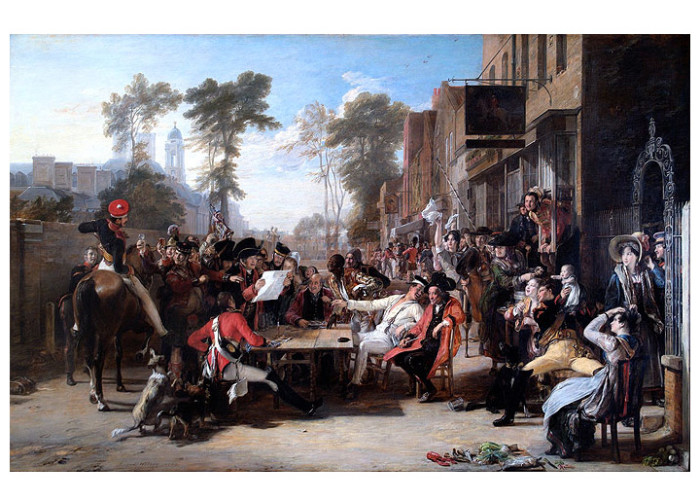The Chelsea Pensioners Reading the Waterloo Dispatch
In this painting by Sir David Wilkie, a group of retired soldiers living at the Royal Hospital in London are shown reacting to news of the British victory at Waterloo. Wilkie’s painting, first exhibited in 1822, depicts Waterloo as the climax of British military efforts during the previous half-century.
The Duke of Wellington’s dispatch, describing the battle, arrived in London on the night of the 21 June 1815. Widespread celebration greeted the news that Napoleon had finally been defeated, ending 23 years of war against France.
The central figure is shown reading a special edition of the London Gazette of Thursday 22 June 1815, which printed the Duke of Wellington’s dispatch. His audience is a motley collection of Londoners outside a pub, but the main group are Chelsea Pensioners in their distinctive red uniforms and black tricorn caps. The scene is Jew’s Row, near the Royal Hospital in Chelsea.
These were soldiers who had retired because of injury, and lived at the Royal Hospital in Chelsea, London. By 1815 there were of these over 38,000 of these veterans drawing a pension from the Hospital – a reflection of Britain’s long and bloody wars around the world.
These conflicts are reflected in the names of the public houses that Wilkie has painted lining the street. It was common for ex-soldiers to turn into publicans, opening taverns with names that honoured their service. We have the Marquis of Granby, commemorating a beloved hero of the Seven Years War (1756-63); the Snow Shoes, commemorating victories in North America; and the Duke of York, commemorating the royal leader of Britain’s campaigns in the 1790s, who later as commander-in-chief oversaw the re-shaping of the British Army in time for it to take the field against Napoleon.
Life was hard for many former soldiers at the time of Waterloo. The Army pension was small, 8 pence a day (roughly £2.15 in today’s purchasing power), and there were few jobs for men disabled by injury. The Royal Hospital was founded by Charles II to care for soldiers “broken by age or war”. It is visible in the background of this painting, on the left.
The Duke of Wellington commissioned this painting from Sir David Wilkie, the most popular genre painter of his day. In 1822, 7 years after the Battle of Waterloo, it was exhibited at the Royal Academy, and was so popular that rails had to be erected to protect it from the crowds. Even today it still captures the popular jubilation after the Battle of Waterloo and the vibrant life of London at that time.
-
Education overview
Sources:
Colley, Linda, Britons, Forging the Nation 1707-1837: Yale, 1992, pp.364-368.
Foster, R.E., “Wellington and Wilkie: Money Well Spent?”, The Waterloo Journal, Vol.35, No.1 (Spring 2013), pp.12-16.
-
Curatorial info
- Originating Museum: Apsley House
- Accession Number: WM 1469–1948
- Production Date: 1822
- Creator: Sir David Wilkie
- Material: Oil on canvas
- Creation Place: London
- Technique: Oil painting
- Size: 158 × 97 centimetres
-
Use this image
You can download a higher resolution image below, but please note the conditions of the licence.
- Rights Holder: English Heritage / Apsley House
- License Type: All Rights Reserved
Find it here
This object is in the collection of Apsley House – English Heritage







